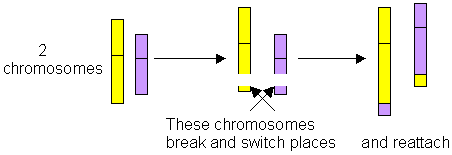In this section
Translocations
What are translocations?
The term "translocation" is used when the location of specific chromosome material changes. There are two main types of translocations: reciprocal and Robertsonian. In a reciprocal translocation, two different chromosomes have exchanged segments with each other:

In a Robertsonian translocation, an entire chromosome attaches to another at the centromere:

This newly formed chromosome is called the translocation chromosome. The translocation in this example is between chromosomes #14 and 21. When a baby is born with this type of translocation chromosome (between #14 and 21), in addition to one normal 14 and two normal 21 chromosomes, the baby will have Down syndrome. This is also called translocation Down syndrome.
Need assistance?
From out of town? The Access Center can provide assistance in coordinating appointments, insurance, etc. Use our online form or call: (414) 266-6300.
